List of Authors
>>About this blog
Recent blog post
|
[Shitamachi Tom]
July 30, 2015 09:00
It's at the height of summer.
In various parts of Chuo-ku, summer festivals and Bon Odori competitions are held, and the heat is full of seasonal and atmosphere.
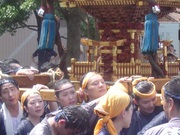 This weekend, the Sumiyoshi-jinja Shirine Grand Festival, one of the best traditional events in the city, will be held. Because it is a festival once every three years, the locals are waiting for the day by pulling their hands. This weekend, the Sumiyoshi-jinja Shirine Grand Festival, one of the best traditional events in the city, will be held. Because it is a festival once every three years, the locals are waiting for the day by pulling their hands.
This time, in particular, "Ieyasu Tokugawa's 400th Anniversary Festival (a commemorative project commemorating the 400th anniversary of the death)" Thank you for the peace of this area that has continued since the Edo era, and Sumiyoshi-jinja Shirine was set in Settsu. In honor of Ieyasu, the country, Tsukuda (currently Osaka City), will be held in large respect.
 Of particular note is that not only the newly-built tour of Miya portable shrine, but also the pre-preserved Miya portable shrine (octagonal portable shrine, Tenpo era), will travel around the town. This may be the first and last time that two large mikoshis are traveling together. Don't miss it! Of particular note is that not only the newly-built tour of Miya portable shrine, but also the pre-preserved Miya portable shrine (octagonal portable shrine, Tenpo era), will travel around the town. This may be the first and last time that two large mikoshis are traveling together. Don't miss it!
The schedule is July 31, as described in the event information of the Chuo-ku Tourism Association (http://www.chuo-kanko.or.jp/event/monthly.php?year=2015 & month=08#event1). It starts on Friday. After the ceremony was held on this day, in the evening, a ceremony will be held in which ritual officials from each town in the Tsukishima district prepare themselves in their yukatas and walk in the shrine to pray for the safety of the festival.
Saturday, August 1 is the Union imperial procession of each town. A number of portable shrines run out of each town and set up in front of the shrine. The powerful voice of the men carrying the portable shrine fills Tsukuda Island.
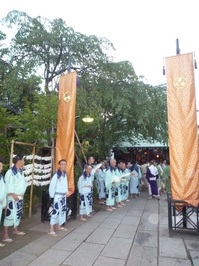 On the 2nd, the Maritime Festival and the Ship imperial procession will be held in the morning. I used to carry the portable shrine and enter the Sumida River, but now I put portable shrine on a boat and pray for the well-being of the district from the water. And during the day it is a tour of Miya portable shrine. Miya Mikoshi, who left Sumiyoshi-jinja Shirine, travels around each town, arrives at the inn in Kachidoki, and spends the night. On the 2nd, the Maritime Festival and the Ship imperial procession will be held in the morning. I used to carry the portable shrine and enter the Sumida River, but now I put portable shrine on a boat and pray for the well-being of the district from the water. And during the day it is a tour of Miya portable shrine. Miya Mikoshi, who left Sumiyoshi-jinja Shirine, travels around each town, arrives at the inn in Kachidoki, and spends the night.
On the 3rd (Monday), Miya Mikoshi will leave Kachidoki this time and return to Tsukuda's headquarters in the form of delivery in each town. The enthusiasm continues until the finale of the festival, "Miyairi".
In addition to these general schedules, the whole area will be full of festival mode for four days, with its own portable shrine and floats cruising, music and drums being unveiled in each town. During periods when there are no cruises in portable shrine, portable shrines are displayed in temporary houses called "Okariya" in each town. If you look closely, there are features one by one, so it is interesting to see and go around in order.
We look forward to this festival, also known as the Water Festival, where the rhythm and shout of portable shrine resonate in midsummer alleys, splashes with rainbows, and smiles of people.
[Sumida Fireworks]
July 27, 2015 09:00
This year, Tsukuda Island is home to Sumiyoshi-jinja Shirine, where the main festival is held once every three years.
When you look at Tsukuda digging from the top of Tsukuda Kobashi, you can see the following precautions.
"This place is buried with large banner pillars and hugs that were allowed to be built by Tokugawa shogunate in the late Edo period (1798), so please do not enter or dig up. Sumiyoshi Tsukuda
It is said that the "pillars" of large banners drawn by Hiroshige, which can be set up at the main festival once every three years, and the "daki" that supports it are buried in the water like a time capsule.
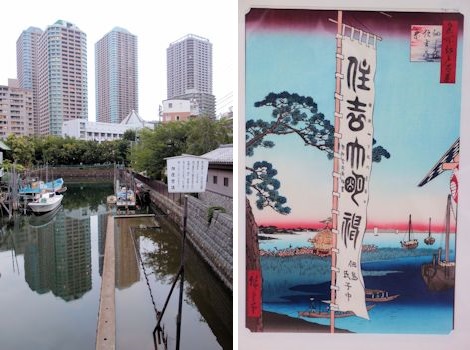
Every time I come here to Tsukuda Island and see this note
"Isn't the tree going to rot because it's buried in the water?"
Yeah
"Isn't it okay until now, but it's rotten and gone this year?"
I don't think about it.
That's why the work of digging this pillar and holding tree, which only happens once every three years. I was a little interested, so I saw it (Sunday, July 5).
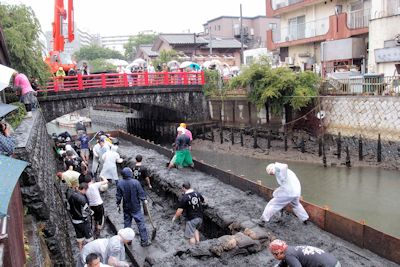
Unfortunately, it was raining on the day.
This digging starts with digging mud until you can see the buried trees, but just looking at getting your feet off the mud, you can see that it is quite hard work.
Then, the buried trees begin to appear and move on to the work of removing them.
A crane is used to remove the tree. Once the mud is dropped in the moat water, it is lifted to Hashigami.
It's repeated many times.

On the other hand, the work of drilling with pillars is performed separately. There are six large banners, which can be set up in six places, but there is a place where three holes can be drilled per place in advance.
I'll dig up the hole.

After the tree, which was the part of the holding tree, was taken out, the six pillars were removed. It is said that the length is close to 20m.

The young people carry that pillar.
This traditional work, the interval of once every three years may be just right to take over.
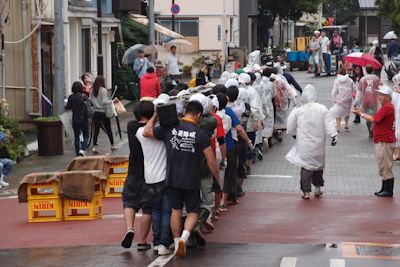
And finally, a tree was assembled to make a large banner.
 As a result, the buried trees were dug out safely this time, and they were ready to set up a large banner. As a result, the buried trees were dug out safely this time, and they were ready to set up a large banner.
According to various research, it seems that the tree needs oxygen to rot, and filling the tree in the water does not let it touch the oxygen.
I don't think old people knew such a theory, but it may have been a very natural knowledge from experience.
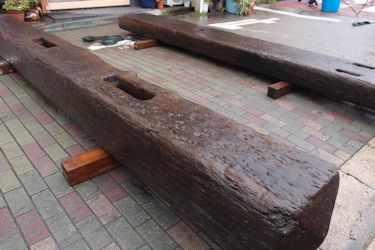
Walking along Tsukishima's Nishinaka-dori (Monja-dori) toward Kachidoki, there is a bridge called "Nishinakabashi", which was replaced last year.
It seems that dozens of pine stakes were embedded under the previous bridge, strengthening the ground and supporting the bridge.
The pine stake was dug out during the replacement without rotten, and is now displayed beside this bridge or reused as a wooden bench.
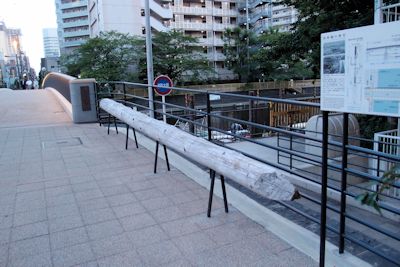 You know that thousands of pine stakes were used under the previous Maru Building in Marunouchi, Chiyoda-ku, and more than 10,000 pine stakes were used as foundation solidification under the station building of Tokyo Station. You may come. It is said that a wooden stake is also hit under the torii gate of Itsukushima-jinja Shrine. You know that thousands of pine stakes were used under the previous Maru Building in Marunouchi, Chiyoda-ku, and more than 10,000 pine stakes were used as foundation solidification under the station building of Tokyo Station. You may come. It is said that a wooden stake is also hit under the torii gate of Itsukushima-jinja Shrine.
It is called the story of this pine stake, the story of the pillar of the large banner of Sumiyoshi-jinja Shirine, and the head of the "power of wood" and "wisdom of the predecessor" drops.
Recently, liquefaction has become a problem in Great East Japan Earthquake, but the "power of wood" has been reviewed, "thinned wood" has not been used, and it has begun to be used as a countermeasure against liquefaction.
By the way, at the main festival of Sumiyoshi-jinja Shirine, I think that a large banner will finally be set up on the 26th and the festival mood will increase.
I'm really looking forward to it because I haven't seen the big banner yet.
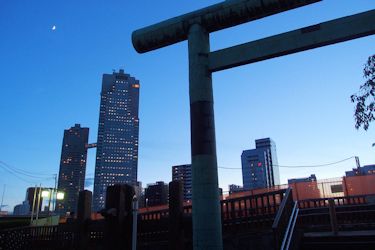
[CAM]
July 25, 2015 18:00
Matsunosuke Nishiyama said, "Edokko is not a specific entity that has a simple structure with a simple hierarchy, but has a double structure."
"Edo kid who is" Ora Edokko "(Edo kid who has appeared mainly after the Kasei period" (self-proclaimed Edo kid), and instead, "The big husbands on the fish banks of Nihonbashi, Kuramae's bill, Kiba's lumber merchants, Seikishima Island and Shinkawa neighborhoods, and merchants who have lived in Edo, such as Edo, who have grown up in Edo, or a real estate.
Nishiyama said, "Not only" self-proclaimed Edokko ", but also rich people with a more advanced culture, who enjoyed themselves alone in a sense of superiority that could be considered to be a reverse of inferiority, I would like to clearly discuss the overall picture of Edokko with a double structure." (10)
Nishiyama's book "Edokko" is also described as "a breakthrough achievement that broke the long-standing theory" (Makoto Takeuchi).
Nishiyama's theory of "double structure of Edokko" can be said to be the same as Yasaburo Ikeda's theory as follows.
>In addition to the husbands of the merchants of "Honmachi" in Edo, the number of people belonging to the craftsman class increased, forming Edokko. Therefore, even if you preach the temperament about money, when targeting people who belong to the class of merchants, mainly in Honmachi in Edo, you must find the temperament of those who have stored dignifiedly, rather than not using the money of the evening. Must. It is dangerous to bring out the temperament from Edokko, a concept that appears in the world of lectures and rakugo. (Nihonbashi Private Note 88)
[CAM]
July 22, 2015 18:00
In 1787, the stylish book “Tsugen Somagaki” (written by Kyoden Santo), look at a golden fish tiger (Shiyachihoko), bathe the tap water in a hot water, and live on the knee. Then, eat the rice of the milling (Ogamizuki), hit the town with a long parasol. It is said that the root bone of the Edo kid is from the middle of the Japanese chopsticks that goes over everything.
However, "Look at the Gold Fish Tiger," the central keep of Edo Castle was destroyed by the great fire of the Meiryaku era in 1657 and has not been rebuilt since then.
In addition, as the city planning of Edo and the large urbanization of the downtown area progressed, water supply was practical by large-scale civil engineering work in terms of drinking water measures, so it is certainly Edo's pride, but the water quality was not always good and the amount of water was not rich.
In 1716 (1716), Otaminami Une (Shusanjin) wrote in a letter sent to Sakanaka, saying, "In Edo, drinking water like a dob of water supply (Kanda Josui, Tamagawajosui, etc.) Some people in Osaka say that they do not work well, but in fact, the water of the Osaka River is extremely clear. " (Ryoichi Okamoto, History of Osaka, 71)
Akinari Ueda, published in 1766 (1766), described the situation of Edo at this time to those who are going to go out of Osaka to Edo, saying, "I can be swallowed by the muddy water of the water supply ... I don't lose the taste of the water of the Yodo River, but I'm sorry to hear the muddy water of Edo ... " (Matsunosuke Nishiyama, "Edo Tsuko," 168)
The above is that Edo was scarce in drinking water, but in Edo at that time there was a shortage of supplies, not just water, and in the end, only boring things could be boasted. In Edo, the one that descends from the top is the best, and the one around the ground is "the one that does not fall." This is "Edo is a place where people can't be invincible, a place that can't be separated at a later date" (Saikaku), and "Edo's things are children's narration, stupids, and severe beginnings" ( Masukodan). ). (Mataji Miyamoto, Kansai and Kanto, 416)
However, the term "child's house, stupid man's house, and the most intrinsic Edo" here refers to people who have been included in Edokko later, and who work for merchants. Not people (mainly people from Kansai). And the real power of commerce in Edo was held by these merchants. (Mataji Miyamoto, Kansai and Kanto, 416)
[Minori]
July 21, 2015 18:00
Hello, Minori. 
This year is the main festival of Sumiyoshi-jinja Shirine.
This time, I would like to introduce the octagonal portable shrine in Sumiyoshi-jinja Shirine and Mori Inari Shrine in Tsukuda 1-chome.
 The octagonal portable shrine of Sumiyoshi-jinja Shirine The octagonal portable shrine of Sumiyoshi-jinja Shirine
<Tenpo era Octagon portable shrine>
Tosho's life (Azuma Terumioya no Mikoto = Ieyasu Tokugawa)
Produced in 1838 (1838) Designation of tangible folk cultural properties in Chuo-ku
It was produced by Shibadaimon Shihoya Sugibei.
It is said to have imitated the Emperor's Goza and Takamiza.
Since the underwater imperial procession was used in the old days, lacquer is applied inside to enhance water resistance.
What happened at the same time
Taizen Sato founded Wada Juku in Yagenbori (the origin of Juntendo University)
<Miya portable shrine "octagonal portable shrine">
Bottom Tsutsuno's Life, Nakatsutsuno's Life, Kamitsutsutsuno's Life (Mikami Sumiyoshi)
Production in 2011 (2011)
What happened at the same time
Toward the 100th anniversary of the Nihonbashi Bridge

(Provided from the winning works of the Chuo-ku Tourism Association Photo Contest)
Source: Bulletin board of Sumiyoshi-jinja Shirine
"Chuo-ku Monoshiri Encyclopedia for Walking (Supervised, Chuo-ku Tourism Certification Committee)"
 Mori Inari Shrine (Tsukuda 1-chome) Mori Inari Shrine (Tsukuda 1-chome)
Magoemon Mori is from Tsukuda-mura, Nishinari-gun, Settsu-kuni (currently Nishiyodogawa-ku, Osaka) following Ieyasu Tokugawa's entry into Edo.
It is said that he went out to Edo and served the Shogun's offering of white fish.
It is also said that Tsukuda Island was built at the mouth of the Sumida River and opened a shop that became the base of the Nihonbashi Fish Bank.
1644 (1644) A fisherman from Tsukuda Village, Nishinari-gun, Settsu-kuni built Tsukuda Island.
Even today, the religion of the residents is strong, and it holds the first noon festival every February.
Source: Origin of Mori Inari Shrine
"Chuo-ku Monoshiri Encyclopedia for Walking (Supervised, Chuo-ku Tourism Certification Committee)"
[Yuyama also only]
July 21, 2015 14:00
It's hot every day.
Is it near the end of the rainy season? Let's kill time in a cool place during the hot summer.
It may be a nearby library, but this month I tried Kabuki.
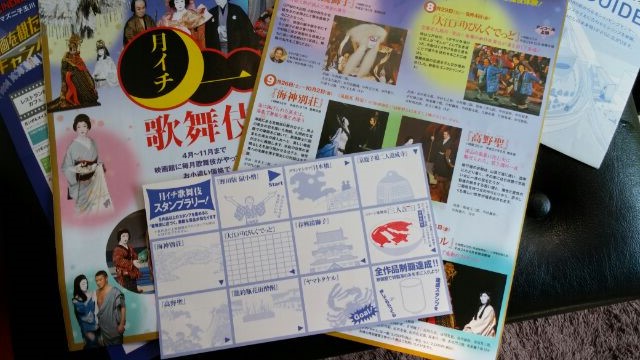
I was very busy last month and I completely forgot to get a ticket!
I had time, so when I saw the Kabukiza ticket on the Kabukiza ticket for the daytime performance "Genji store (Genji store)" and "Spider thread" and "Spider thread"! No seats available!
Then "Cinema Kabuki".
"109 Cinemas" was made in Futago-tama, and it was very close, so I went out. I watch opera every season in the metropolitan Live Viewing movie, but Cinema Kabuki was the first time. The good or bad in a movie is that you can hear all the voices, as well as operas. On the main stage, you can see that the volume of voice is different. The performance is "Yoshizo Sannin". I enjoyed it in the cool and beautiful building.
But~! That's right! If you stand up, you can see the main stage.
Is it okay if it's an hour before the sale of the standing ticket? I went out a few days later and lined up. I saw it throughout the day.
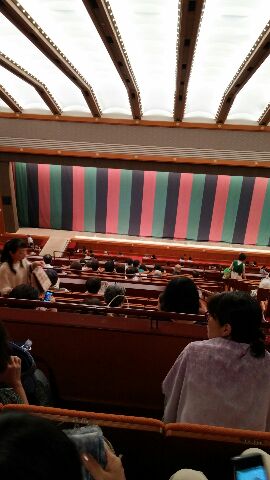 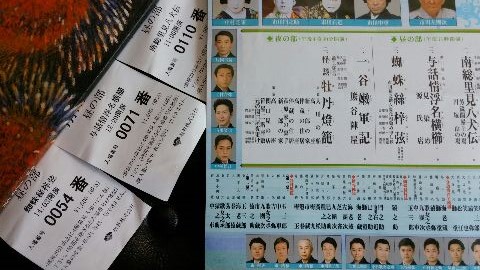
The first act is "Minamiso Satomi Hakkenden", but since the time is not long, it is patient with standing. Most customers will return after seeing one act. Foreign people with blond hair just come to Kabuki experience. The second and third acts sat in the center.
I saw the performance I wanted to see, and the performance was quite good. It was a half day of satisfaction.
But it's been a long time since I had a standing seat. Once a student. After that, when Muty was conducting in Scalar, Milan, I bought it once from an Italian duff shop. It's okay because I was able to sit in the seat, but I guess I'm so young that I can see Kabuki's three acts while standing. Don't forget to buy an advance sale for September's "Previous Hagi"!
|
Links
|
 This weekend, the Sumiyoshi-jinja Shirine Grand Festival, one of the best traditional events in the city, will be held. Because it is a festival once every three years, the locals are waiting for the day by pulling their hands.
This weekend, the Sumiyoshi-jinja Shirine Grand Festival, one of the best traditional events in the city, will be held. Because it is a festival once every three years, the locals are waiting for the day by pulling their hands. Of particular note is that not only the newly-built tour of Miya portable shrine, but also the pre-preserved Miya portable shrine (octagonal portable shrine, Tenpo era), will travel around the town. This may be the first and last time that two large mikoshis are traveling together. Don't miss it!
Of particular note is that not only the newly-built tour of Miya portable shrine, but also the pre-preserved Miya portable shrine (octagonal portable shrine, Tenpo era), will travel around the town. This may be the first and last time that two large mikoshis are traveling together. Don't miss it! On the 2nd, the Maritime Festival and the Ship imperial procession will be held in the morning. I used to carry the portable shrine and enter the Sumida River, but now I put portable shrine on a boat and pray for the well-being of the district from the water. And during the day it is a tour of Miya portable shrine. Miya Mikoshi, who left Sumiyoshi-jinja Shirine, travels around each town, arrives at the inn in Kachidoki, and spends the night.
On the 2nd, the Maritime Festival and the Ship imperial procession will be held in the morning. I used to carry the portable shrine and enter the Sumida River, but now I put portable shrine on a boat and pray for the well-being of the district from the water. And during the day it is a tour of Miya portable shrine. Miya Mikoshi, who left Sumiyoshi-jinja Shirine, travels around each town, arrives at the inn in Kachidoki, and spends the night.




 As a result, the buried trees were dug out safely this time, and they were ready to set up a large banner.
As a result, the buried trees were dug out safely this time, and they were ready to set up a large banner.
 You know that thousands of pine stakes were used under the previous Maru Building in Marunouchi, Chiyoda-ku, and more than 10,000 pine stakes were used as foundation solidification under the station building of Tokyo Station. You may come. It is said that a wooden stake is also hit under the torii gate of Itsukushima-jinja Shrine.
You know that thousands of pine stakes were used under the previous Maru Building in Marunouchi, Chiyoda-ku, and more than 10,000 pine stakes were used as foundation solidification under the station building of Tokyo Station. You may come. It is said that a wooden stake is also hit under the torii gate of Itsukushima-jinja Shrine.




